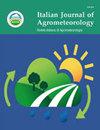Effects of phenological stages, growth and meteorological factor on the albedo of different crop cultivars
IF 0.8
4区 农林科学
Q2 AGRONOMY
Italian Journal of Agrometeorology-Rivista Italiana Di Agrometeorologia
Pub Date : 2022-07-19
DOI:10.36253/ijam-1445
引用次数: 1
Abstract
Albedo is a key component of the atmospheric, climatologic and remote sensing studies by means of global warming, energy balance, evapotranspiration, climate models, hydrological cycle etc. For these reasons, the accurate determination of surface albedo has become more important. In this study, the variation of measured albedo values of winter wheat, barley and sunflower cultivars according to phenological stages was investigated for the first time in the northwestern part of Turkey. Additonally, influences of leaf area index as growth indicator and rainfall as meteorological variable on albedo were also analyzed. The average albedo values of winter wheat, barley and sunflower in both growing periods varied from 0.176 to 0.190 for winter wheat, from 0.171 to 0.189 for sunflower and from 0.187 to 0.214 for barley cultivars. According to phenological stages, the minimum and maximum average albedo values were found for winter wheat as 0.121 between sowing and germination and 0.247 between stem formation and head emergence; for sunflower as 0.150 between sowing and germination and 0.212 between leaf initiation and immature bud; for barley as 0.144 sowing and germination and 0.261 between head emergence and flowering stages. Additionally, significant relationships were found between albedo and leaf area index for winter wheat, barley and sunflower as r2=0.87, r2=0.82 and r2=0.77, respectively.不同作物品种的生育期、生育期和气象因子对反射率的影响
反照率是全球变暖、能量平衡、蒸散、气候模型、水文循环等大气、气候和遥感研究的关键组成部分。因此,准确确定地表反照率变得更加重要。在本研究中,首次在土耳其西北部调查了冬小麦、大麦和向日葵品种的反射率测量值随酚期的变化。此外,还分析了叶面积指数作为生长指标和降雨量作为气象变量对反照率的影响。冬小麦、大麦和向日葵在两个生长期的平均反照率值变化范围为:冬小麦为0.176至0.190,向日葵为0.171至0.189,大麦品种为0.187至0.214。冬小麦从播种到发芽的平均反照率最小值和最大值分别为0.121和0.247;向日葵从播种到发芽为0.150,从叶片萌生到幼芽为0.212;大麦在播种和发芽期间为0.144,在出苗和开花阶段之间为0.261。此外,冬小麦、大麦和向日葵的反照率与叶面积指数之间存在显著关系,分别为r2=0.87、r2=0.82和r2=0.77。
本文章由计算机程序翻译,如有差异,请以英文原文为准。
求助全文
约1分钟内获得全文
求助全文
来源期刊

Italian Journal of Agrometeorology-Rivista Italiana Di Agrometeorologia
AGRONOMY-ENVIRONMENTAL SCIENCES
CiteScore
2.10
自引率
8.30%
发文量
6
期刊介绍:
Among the areas of specific interest of the journal there are: ecophysiology; phenology; plant growth, quality and quantity of production; plant pathology; entomology; welfare conditions of livestocks; soil physics and hydrology; micrometeorology; modeling, simulation and forecasting; remote sensing; territorial planning; geographical information systems and spatialization techniques; instrumentation to measure physical and biological quantities; data validation techniques, agroclimatology; agriculture scientific dissemination; support services for farmers.
 求助内容:
求助内容: 应助结果提醒方式:
应助结果提醒方式:


